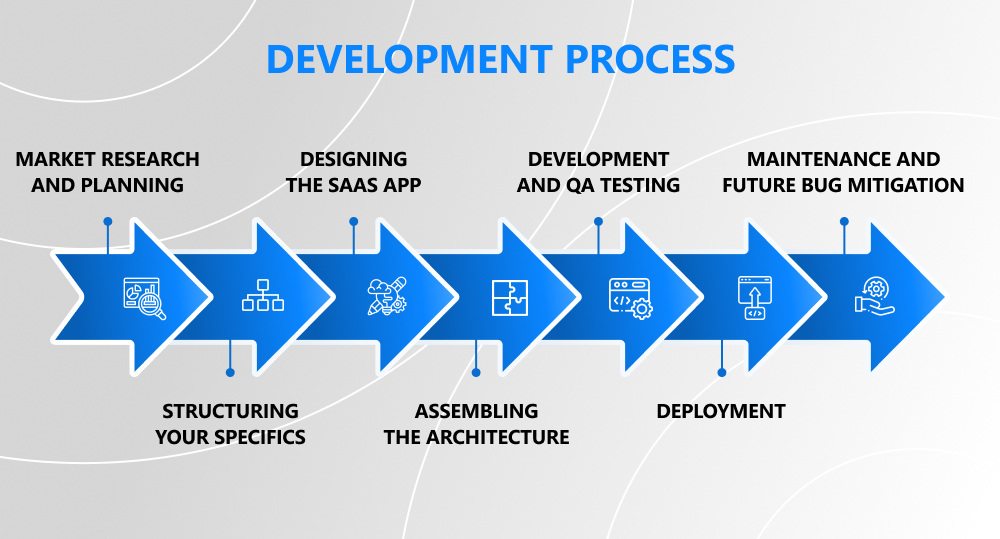Let’s answer this burning question, what is SaaS in web development? This is a cloud-based model that made its debut in the 1990s and has been revolutionizing the software industry as we know it ever since. It has brought about significant changes in the way software is delivered and consumed, making it more accessible and cost-effective for businesses of all sizes. Through streamlined processes, SaaS tools provide organizations with more opportunities to improve their marketing efforts and create solutions.
How will using SaaS benefit your web design and development efforts? Read on to find out if this cloud is the right one for you to hop onto!
written by:
Alexey Krutikov
Project Manager
Contents
What Are SaaS Platforms?
SaaS, or Software as a Service, is a software distribution approach that allows customers to access cloud-based programs via the web. This model, established back in the 1990s, is a close relative of two other widespread models: PaaS, platform-as-a-service, and IaaS, infrastructure-as-a-service. With SaaS, you no longer need to download various applications, run them on your computer, and have them take up a significant amount of valuable storage space or computing resources. As the Beatles put it, "All you need is... the internet!" All the software you require is available on the internet and is typically accessible via any device that has internet access.
But how exactly is this possible? Let’s compare it to a rental car service. Although there are both pros and cons when it comes to buying versus renting a car, a rental service can easily be just as if not more effective for your transportation needs. You don’t need to worry about long-term storage, general upkeep, or affordability; it’s definitely a win. All the worries that come with owning a car are for the car rental service to worry about, not you.
Much like the burden of owning a car is eliminated when you use a rental service, the same is true when you use a SaaS application. No stress about the need to purchase licensed software and spend valuable time setting it up for other users. The SaaS vendor handles all the tech-savvy elements of development and general upkeep.
SaaS vs. PaaS vs. IaaS
Earlier, we momentarily touched on the other models when it comes to cloud computing: PaaS and IaaS. So before we head into the wondrous world of SaaS web development, let's briefly discuss the difference between these services.
SaaS: Software as a Service
As previously discussed, a SaaS platform is a cloud application that is the most widely used choice for organizations. Through the internet, SaaS provides consumers with programs that are controlled by an outside supplier. Approximately 11,000 SaaS firms operate worldwide, which means a vast majority of those run through the web, resulting in no downloads or plugins to do on the customers' part.
PaaS: Platform as a Service
PaaS is another one of the trio of cloud infrastructure services that offer cloud components (hardware, software, and infrastructure) that are primarily utilized for web applications. It provides developers with a platform on which they can develop and modify their apps. The outside vendor can handle all networking, storage, and server infrastructure while the developers retain application oversight.
IaaS: Infrastructure as a Service
This is a cloud infrastructure service that consists of extremely flexible and automatic computational capabilities. The difference is that It provides complete independent access to and management of hardware, storage, networking, and other services, rather than the outside vendor doing it. Like SaaS, IaaS allows organizations to acquire resources instantly, whenever they are required.
The Impact of SaaS on Web Development and Design
The impact SaaS has had on both web design and development has been major, with, as of 2020, the typical number of SaaS apps used by companies being 80. When it comes to online creation, SaaS has completely revolutionized the industry.
Advancements in software have enabled cutting-edge features to be made easier to implement, and more widgets, add-ons, and plugins are available to designers. Additionally, web software programs are kept up-to-date, allowing for analytics-informed design. Content management is also streamlined, making it easier for web designers to freelance. User experience (UX) is becoming even more important in the design process, as is the adoption of artificial design intelligence (ADI) in order to speed up the process. All of these developments are allowing for a new era of web design and making it easier for designers to create high-quality and accessible websites.
Benefits of SaaS Web Development
The advantages of a SaaS business app are not just limited to the business or user only; there are plenty of benefits for both parties.
Benefits for SaaS Business Owners
Attract New Customers
The more companies that wish to convert to using SaaS apps, the more opportunities you have to attract new users. Furthermore, low-cost recurring payments make software accessible even for startups with tight resources, as opposed to a medium business with a larger budget.
Break into a Growing Market
As stated above, by attracting more users, your opportunity to break into the market greatly increases. Given the advantages that software as a service can offer users, it should come as no surprise that the market is rapidly expanding. In a study by BetterCloud, 85% of business applications will be SaaS-based within the next few years.
Increase Revenue
Because of how successful SaaS is for startups, medium businesses, and even large corporations, it is a constant source of revenue. This enables corporations to establish a strategy and execute frequent development initiatives that keep their consumers satisfied and subscribed, thus keeping the cash flow coming in.
Benefits for SaaS Users
Accessibility
A SaaS app is accessible from any internet-connected device because it is a cloud-based solution.
Flexibility
Users of SaaS products are at liberty to change their subscription plans at any given point in time. Whether that be switching to a different payment method, upgrading their current subscription, or even downgrading, the options are always readily available.
Frequent Updates
SaaS web apps are constantly updated behind-the-scenes, so users never need to worry about manually doing it themselves; the newest version is right there when they log in. Unfortunately, the same can't currently be said for mobile and desktop applications, as users are still required to download the latest version upon notification.
Reliability
Customers never need to worry about their SaaS application server failing; the program will continue to function. This is because a cloud is a reliable network of servers placed worldwide.
Types of SaaS Applications
SaaS platforms extend to both business-to-business and business-to-consumer models; although they can overlap, the applications are different.
B2B
Marketing Software
This model is used for bringing in new clients and accelerating business growth overall. To enhance their stance in the market, businesses will use SMM platforms and marketing analytics to gauge results and increase their marketing efforts.
ERP Systems
An ERP system is a cloud-based web program that includes a number of modules targeted at streamlining and optimizing internal corporate operations. They are large units of software that encompass inventories, financial reporting, HR, CRM, and other components. Oracle Cloud ERP and SAP S/4HANA Cloud are two of the most widely recognized ERP software products.
Collaboration Tools
In 2020, the usage of collaboration SaaS increased by 32% as a result of the COVID-19 pandemic. Working from home became the new norm for many organizations, with employees using programs like HubSpot, Slack, and Zoom to stay up-to-date with work processes.
Project Management Tools
Companies can successfully handle day-to-day business procedures through the use of cloud-based SaaS project management tools. You’re probably familiar with some of the more popular SaaS apps like Asana and Jira already, which assist collaborators in efficiently interacting and accelerating projects.
B2C
SaaS web development services aren’t just limited to business-to-business purposes; there are plenty out there for B2C use.
Streaming Services
Streaming services are among the most prevalent when it comes to SaaS for B2C, with Netflix and Spotify being the most popular among the "common folk". The top leading American streaming service, Netflix, enables film lovers all over the world to watch their favorites on any device with internet access. Another popular subscription service is Spotify. As an affordable online alternative to the days of purchasing albums separately, consumers now have access to a plethora of music.
E-learning Applications
Aside from streaming services, e-learning applications are also very prominent in the SaaS market. Duolingo and Coursera are two prevalent online learning programs that provide their services using the SaaS model. Duolingo allows their target audience to either select their free program or the Plus subscription, as opposed to Coursera, which only offers one subscription model option of a $59 monthly fee but gives unlimited user access to their library and also obtains globally recognized certifications.
SaaS Website Development Process
Software as a service is one of the fastest-growing tech tools in the webspace; as of 2023, its market is expected to be valued at more than $195 billion. Creating your own SaaS app will allow your business to expand, as it offers more opportunities for it to flourish within the growing market. However, since the process is quite different from building a conventional app, let's take a look at how to create your own SaaS product.
1. Market Research and Planning
Every great idea will always remain an idea without a plan in place to set things in motion. At this stage, you not only need to examine the right technologies for users but also market research for your user base, the purpose of the app's components, and the important features you'll need. Popular feature prioritization methods for an MVP include MoSCoW, Matrix, and Kano.
2. Structuring Your Specifics
Once you've done the research and laid out your plans, it's time to begin organizing the development of your SaaS application. This involves creating the appropriate documentation to assist your development team in building the software you want to obtain. During this stage, you'll have a business associate schedule multiple meetings to learn about the specifics of your desired SaaS product and prepare documentation, including but not limited to:
Vision and Software Requirements Specification (SRS)
Represents cloud application needs and outlines the features it should have in addition to technical requirements (such as responsive design and prerequisites), project goals, and user demographics.
Risk Assessment and Mitigation Plan
A forecast of the hazards you could experience while constructing your cloud-based SaaS service, as well as strategies for mitigating those risks.
Feature Breakdown
A table including all the features you intend to include in your SaaS application, as well as the estimated time frame for their development and priority.
Cost Estimation
A table containing the anticipated budget for SaaS web development.
3. Designing the SaaS App
UI/UX design is arguably one of the most significant steps in the process of building a SaaS app. Prior to the development of the product, you need to choose a web design that aligns with the expectations of your target audience. Consider which devices your intended users will use when designing your application's layout and user experience. Since SaaS products are compatible with both PCs and mobile devices, a UI/UX expert will create designs for devices of various dimensions so that your users are able to access the web app anywhere.
4. Assembling the Architecture
The solid foundation for any good SaaS application is a sound software architecture that fulfills the technical criteria of the business partners involved. Given that SaaS architecture is cloud-based, databases, archiving, and other features are hosted in the cloud rather than on physical servers.
5. Development and QA Testing
At this phase, both front- and back-end developers will be working on the SaaS application. Simultaneously, QA engineers will conduct usability testing and ensure that every component of the functionality operates correctly, both by itself and as an element of an entire system. An iterative approach is applied to the creation of SaaS applications, meaning the entire web design and app are developed simultaneously. Developers often begin with a minimally viable product (MVP) that comprises only the essential elements to fulfill your users’ fundamental demands.
6. Deployment
The most exciting stage is, undoubtedly, deploying your SaaS web app. This involves developing an MVP iteration of a cloud-based SaaS program available to your final users. Generally, a DevOps professional in your team will compile all the components of the new code for deployment and integrate the complete codebase into operation throughout this stage.
7. Maintenance and Future Bug Mitigation
Once your SaaS cloud computing app has been deployed, you can now concentrate on evaluating its success among users. Through collecting and assessing feedback, you can identify what to enhance, along with any additional features your users may require. Apart from that, SaaS programmers can assist you in fixing any current issues and creating plans to maintain efficiency well into the future.
FAQ
What Is SaaS in Web Development?
SaaS is a software license and delivery model that substitutes the conventional software method of licensing the software product or service only once. It is an increasingly prevalent business model since it provides ongoing income in the form of yearly or monthly payments.
Is SaaS Important in Web Development?
Using a SaaS product is the key to success in the web development industry. Software advancements have made it possible for developers to take control of their work and shorten the design process, allowing creators to expand on their web design skills and create a better overall user experience.
What Is a SaaS Developer?
A SaaS developer can be either a freelancer or part of an organization that operates in the development and upkeep of SaaS applications.
What Does a SaaS Developer Do?
SaaS developers often specialize in designing entire solutions utilizing web-based technologies such as HTML, CSS, Javascript, PHP, and other suitable platforms. They are likewise well-versed in database design and administration, software design patterns like MVC, and a variety of other development approaches and processes.
How Do I Create a Website with SaaS?
Here are the steps you need to follow to create your own SaaS product and break into the software market:
- Do market research on your target audience and begin planning what features you’ll need within your web design.
- Next, create the proper documentation outlining your specifics to assist your SaaS business team.
- Then begin designing your SaaS application with UI/UX specialists with a focus on providing optimal solutions for user needs.
- After the design stage, full development of the SaaS web design product takes place. In addition, QA testing is conducted to make sure everything is running smoothly.
- Once everything has been properly tested, it is now time to deploy your SaaS solutions.
- The last step is maintaining your product to make sure it has the latest features and fixing any potential bugs or glitches that may occur.
Don’t Pass on SaaS
The impact SaaS has been having on businesses dates all the way back to the 1990s, when it was launched. Ever since then, it has been paving the way forward for e-commerce websites, marketing software, ERP systems, streaming services, and more, offering the best solutions for consumers and skyrocketing businesses to success. Building your own SaaS product will not only benefit your users but also give you and your company prolonged benefits well into the future.
If you’re looking to begin developing your own SaaS application, contact us today to see how we can help your business soar high in the cloud computing sky!

Contacts
Feel free to get in touch with us! Use this contact form for an ASAP response.
Call us at +44 151 528 8015
E-mail us at request@qulix.com










